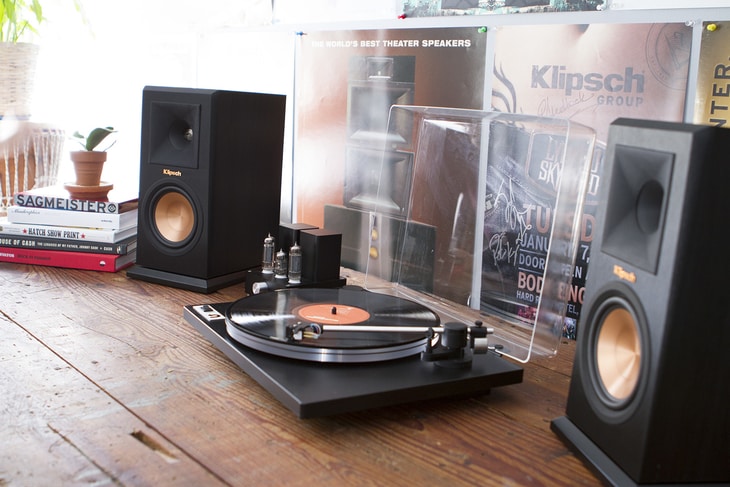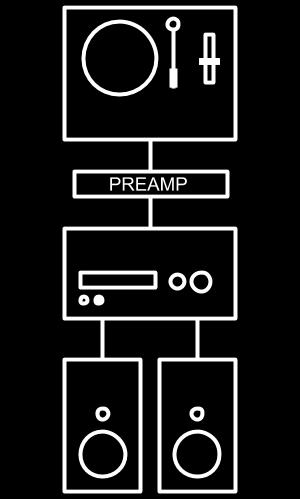
You might have a vintage turntable in your basement that you want to put back in use. Or you might plan to purchase your first ever record player.
And you are asking yourself if you can connect your turntable directly to speakers.
Well, you sometimes can. But not always. It depends on the type of turntable and speakers you have.
You can connect your turntable directly to speakers if the speakers are powered speakers. Powered speakers have the amplifier built in and don’t need a separate amplifier. Also, there must be a phono preamp built into the turntable or into the powered speakers.
So, to connect a turntable directly to speakers you will need:
- Powered speakers
- A phono preamp built into the turntable or speakers
If this is your stereo setup, you can connect your turntable directly to speakers. Either with a standard RCA signal cable or wirelessly if you have a turntable and powered speakers that support wireless Bluetooth connectivity.
You can check out my 10 Great Turntable and Speaker Combos article to find 10 hand-picked turntable and powered speaker systems that connect directly.
If your turntable or speakers don’t include a built-in preamp or your speakers don’t have a built-in amplifier, it will unfortunately not work to connect them directly.
You cannot connect a turntable to standard passive speakers without also including a standalone amplifier in the setup.
And you cannot in any circumstance skip the all-important phono preamp in a vinyl setup.
To check if a turntable has a built-in preamp, see if it has a LINE output or a PHONO/LINE switch. If it has, then you are good.
You can find my recommended turntables with a built-in phono preamp in this article.
If your speakers include a phono preamp, there will be a PHONO input or a PHONO/LINE switch on the back of one of the speakers.
To check if speakers are powered, as opposed to passive, check if the speakers have a power plug. Speakers that connect to power have a built-in amplifier.
The figure below illustrates what a setup where a turntable connects directly to speakers needs to look like. We can see that the preamp is built into the turntable. And that the speakers have a built-in amplifier. (It also work if the preamp is built into the powered speakers instead of the turntable.)

If you are looking for an affordable way to play vinyl records, a setup like illustrated above could be a good solution for you. I highly recommend the Audio-Technica AT-LP60XBT turntable and the Edifier S1000BT powered speakers as a beginner setup. They have received great reviews and connect both through cable and through wireless Bluetooth. If you want to spend less money, you can opt for the Edifier R1280BT powered speakers.
I also have a complete guide on recommended turntables and powered speaker systems that connect directly.
There are four components that must all be present in every vinyl-playing stereo setup.
- Turntable
- Preamp
- Amplifier
- Speakers
If one of those components is missing, then the stereo won’t play vinyl records.
I guess that is obvious when it comes to turntable and speakers, but not everybody understands the function of the preamp and the amplifier when just starting out on their vinyl journey.
But don’t worry. When you are finished reading this article, you will be an expert on preamps, amplifiers and stereo setups.
In some stereo setups, the four components are all standalone components. Four separate boxes.
Like this.

And in other stereo setups some of the components are bundled together.
- The preamp can be integrated in the turntable
- The preamp can be integrated in the amplifier
- The amplifier can be integrated in the speakers
- And the preamp can be integrated in powered speakers as well
I will explain the function of the four essential stereo components and go through all the different vinyl-playing stereo configurations later in this article, but first, a few words on the pros and cons of connecting a turntable directly to speakers.
Pros of connecting a turntable directly to speakers
#1 Cost. If you are on a budget this is generally the lowest cost option for a vinyl playing stereo setup. If we ignore the really low cost (and often low quality) gear being sold, we are talking about around $150 for a beginner turntable with built-in preamp and around $150 for a decent pair of powered bookshelf speakers. Buying turntable, preamp, amplifier and speakers as standalone components will generally cost quite a bit more.
#2 Fewer boxes. Not rocket science, but fewer boxes that bundle components together need less space. You don’t have to find space for a standalone preamp and a standalone amplifier. The setup will look tidy. It also becomes much easier to take the setup with you somewhere.
#3 Fewer cables. You only need one signal cable to connect the two units together. Plus two power cables that connect both units to power. That is neat. Buying all components as standalone will need more signal cables, cables to ground the preamp, speaker wires. That is and looks a bit messier.
Cons of connecting a turntable directly to speakers
#1 Sound. If you are looking for high fidelity sound, you will generally be better off buying standalone gear. The number one reason why manufacturers sell gear that bundle components together is to make it more affordable. And not to make it sound better. So standalone components will generally produce better sounding music than gear that bundle components together.
#2 Upgradability. As components are bundled
#3 Flexibility (few inputs). If you have a lot of sources that you want to connect to the setup, buying powered speakers might not be the best option as they usually have few input connectors. Buying a standalone audio receiver that drives passive speakers will give you options to connect a CD player, DVD player, a radio, your TV, a digital streamer etc. But powered speakers will generally not have that option.
The four necessary components in a vinyl-playing stereo
Sorry if I repeat myself, but as already said, there are four components that must be present in a stereo setup for it to play vinyl records.
- Turntable
- Preamp
- Amplifier
- Speakers
Let’s look at them in more detail before we get to the five possible configurations of a vinyl playing stereo setup.
The first one is the good old turntable.
The turntable
I guess we all know this one.
There is one thing really worth mentioning tho.
There are two variants when it comes to what kind of signal a turntable outputs.
Some turntables output a PHONO signal.
And some turntables outputs a LINE signal.
A turntable that outputs a PHONO signal will need to be hooked up to a preamp. And a turntable that outputs a LINE signal will have a built-in preamp.
So turntables come with and without built-in preamps.
If your turntable has a preamp built in, you are good to go. It can be hooked up to an amplifier or to powered speakers.
But if your turntable does not include a preamp, you will need a standalone preamp, or an amplifier or powered speakers with one built-in.
So make sure that your turntable has a built-in preamp and outputs a LINE signal if you want to connect it directly to speakers.
The preamp
The preamp is a component that cannot be left out in a vinyl-playing stereo setup.
It has two important tasks.
The first one is to correct the tone of the signal that is picked up by the turntable. When a record is carved, the bass (lower tones) of the music is significantly reduced and the treble (higher notes) are significantly increased. This is because lower tones take up more physical space on the records (wider grooves) than higher tones. So to be able to space more than one song on each side of a record this RIAA equalization technique is used.
So the first (and very important) task of the preamp is to correct the tone of the signal so that the music will sound right.
The other task is to boost the tiny PHONO signal that is picked up by the turntable to what is called a LINE level signal. LINE level is a standard signal level that is outputted by all consumer music equipment like CD players and DVD players. And that can be inputted to an amplifier. Or to powered speakers.
The amplifier
The function of the amplifier (also called receiver) is to amplify the music signal so that it is strong enough to drive the speakers.
In addition, an amplifier (or receiver) usually includes input selector, digital to analog converter for digital music input, functionality for surround sound, radio, etc.
And sometimes also a PHONO input and a built-in preamp.
So just as with turntables, amplifier/receivers also come with and without built-in preamps.
The speakers
Speakers convert the power-amplified music signal to sound in the air.
If the speakers are passive they need a standalone amplifier to drive them.
But if they are active or powered they have a built-in amplifier. Which means that any source that outputs a LINE signal can be connected to them. Including a turntable with built-in preamp.
So to connect your turntable directly to speakers, make sure that you run active/powered speakers.
(Powered speakers with built-in preamp have become more popular recently, but most powered speakers still don’t include a phono preamp.)
Stereo Configurations
In total there are five different ways to configure a stereo setup that plays vinyl records. As we have seen, only one of them allows us to connect a turntable directly to speakers.
- Turntable with built-in preamp
- Powered speakers
But to see which options that actually are available, all the five configurations are described in brief below. For a more in-depth review of this, please check out this article.
Setup One
- Turntable with built-in preamp
- Powered speakers
(This system will also work if the preamp is included in the powered speakers instead of the turntable.)

Setup Two
- Turntable with PHONO output
- Standalone preamp
- Powered speakers

Setup Three
- Turntable with built-in preamp
- Amplifier/Receiver
- Passive speakers

Setup Four
- Turntable with PHONO output
- Amplifier/Receiver with built-in preamp
- Passive speakers

Setup five
- Turntable with PHONO output
- Standalone preamp
- Amplifier/Receiver
- Passive speakers

Related questions
What is the difference between powered and passive speakers? Powered speakers (or active speakers) have the power amplifier built-in. So they don’t need to be driven by a standalone amplifier/receiver as passive speakers do. Powered speakers can often be connected wirelessly (Bluetooth) so that no signal cables are necessary to play music. Powered speakers connect to power. Passive speakers don’t.
What is the difference between an amplifier and a stereo receiver? An amplifier is technically speaking a component that takes a low-level signal from an input source and boosts/amplify it so that the signal is stronger on the output side. It can, for example, take the signal from a CD player and boost it so that it can power speakers. A receiver, on the other hand, is basically an amplifier with a few extra features built-in. A receiver can have a built-in radio, built-in digital to analog converter (DAC), built-in Dolby surround decoder, etc. etc. In today’s audio/video slang the terms are often used in interchangeably.